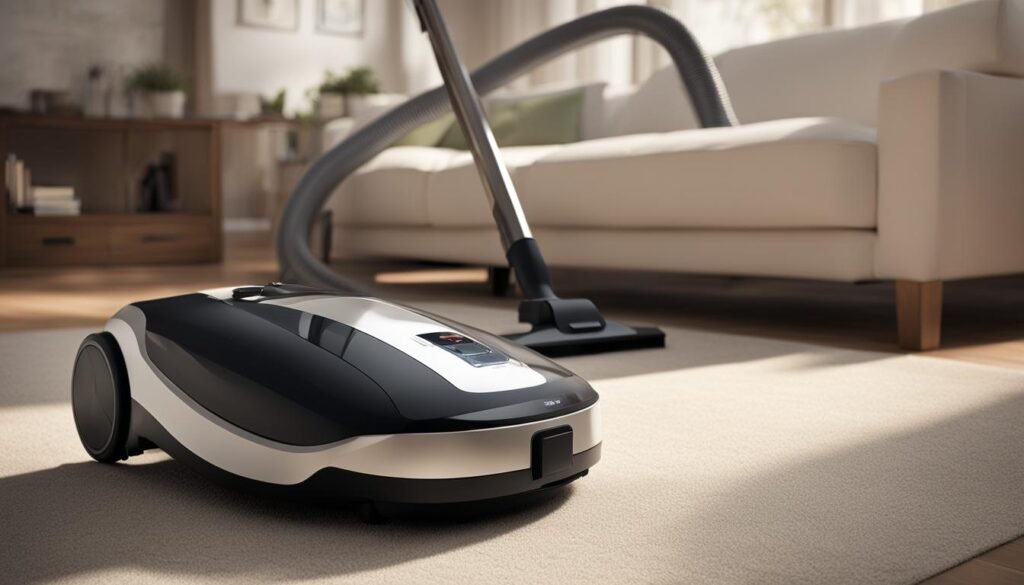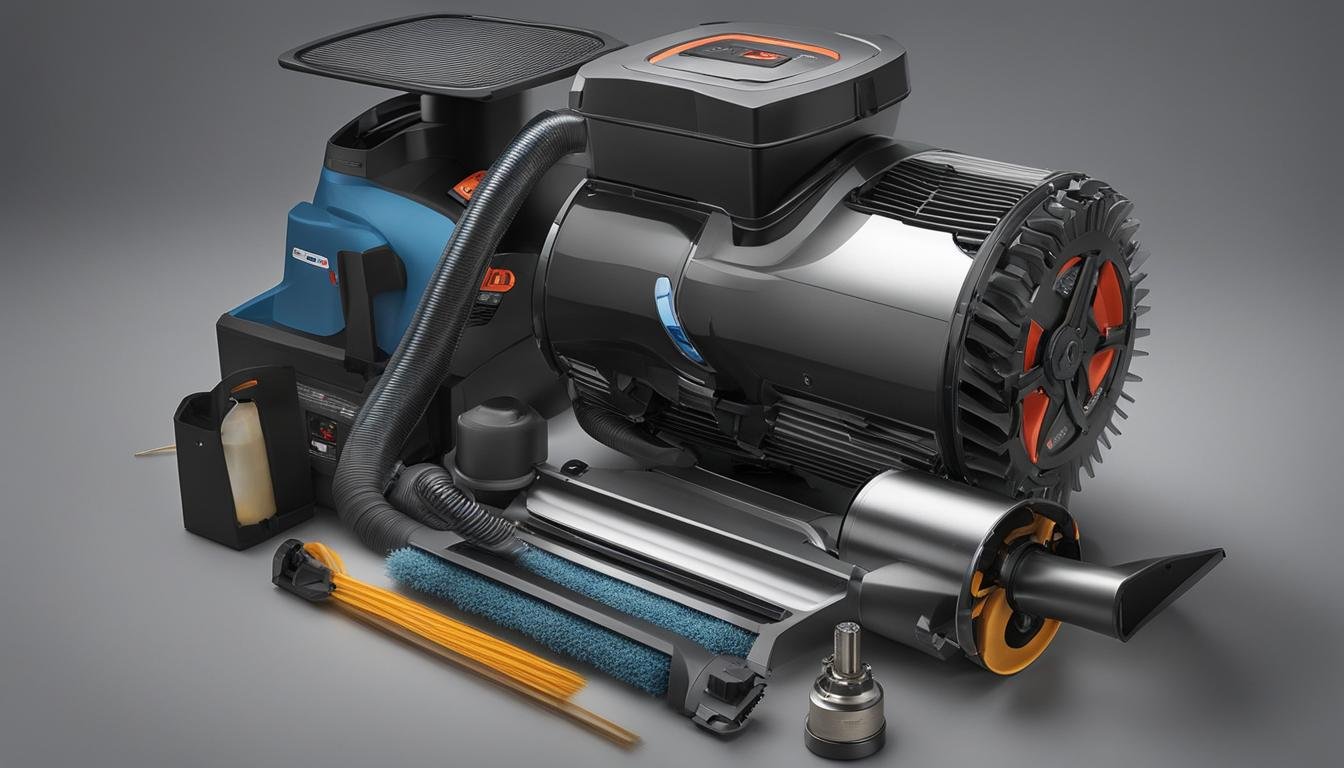Have you ever wondered what makes a vacuum cleaner such an efficient cleaning tool? Well, you’re in the right place. In this article, we will explore the fascinating world of vacuum cleaners and uncover whether they qualify as compound machines. Let’s dive in!
Key Takeaways:
- A compound machine is a combination of two or more simple machines working together to make work easier.
- A vacuum cleaner utilizes simple machines like levers, pulleys, and wheels and axles to perform its cleaning functions.
- Understanding how a vacuum cleaner works can help you choose the right type for your cleaning needs.
- Vacuum cleaners offer advantages such as time-saving, improved indoor air quality, and versatility.
- Vacuum cleaners have become an essential household appliance for effective and convenient cleaning.
Now, let’s explore the inner workings of a vacuum cleaner and discover how it performs its cleaning magic!
How Does a Vacuum Cleaner Work?
The inner workings of a vacuum cleaner are fascinating and rely on advanced technology and design to deliver efficient cleaning performance. Most modern vacuum cleaners operate on the principle of suction, utilizing vacuum cleaner technology to effectively remove dirt and debris from various surfaces.
At the heart of a vacuum cleaner is an electric motor that powers the cleaning process. This motor creates a partial vacuum, generating suction that draws in dirt and debris. Connected to the motor is a fan or impeller that generates a stream of airflow, creating a powerful suction force that lifts dirt and transports it into a collection bag or canister.
While the basic functionality remains the same across different types of vacuum cleaners, such as upright, canister, handheld, and robotic models, each type may have unique features and design attributes that enhance its cleaning capabilities.
Components of a Vacuum Cleaner
A vacuum cleaner is made up of various components that work together to ensure effective cleaning. Below are some of the key components found in most vacuum cleaners:
- Motor: The electric motor powers the vacuum cleaner, providing the necessary suction force.
- Fan/Impeller: The fan or impeller generates airflow, creating suction to lift dirt and debris.
- Filters: Vacuum cleaners typically have filters to trap fine particles and prevent them from being released back into the air.
- Brushes/Rollers: These components agitate the surface being cleaned, dislodging dirt and debris for easier suction.
- Bag/Canister: The collection bag or canister stores the dirt and debris that is suctioned into the vacuum.
- Attachments: Vacuum cleaners often come with various attachments, such as crevice tools and upholstery brushes, to tackle different cleaning tasks.
By combining these components, vacuum cleaners are able to effectively remove dirt, dust, and allergens from carpets, floors, upholstery, and other surfaces.
The image above illustrates the complex internal workings of a vacuum cleaner, showcasing the vacuum cleaner’s components and how they interact to create a clean and healthy environment in your home.
Advantages of Vacuum Cleaners
When it comes to keeping our homes clean and tidy, vacuum cleaners have become an indispensable tool. These modern cleaning devices offer numerous advantages over traditional cleaning methods, making them an essential part of any household. Let’s explore some of the key benefits of using a vacuum cleaner.
Efficiency and Time-Saving
One of the significant advantages of vacuum cleaners is their efficiency in cleaning. with their powerful suction capabilities, vacuum cleaners allow users to clean larger areas in a shorter amount of time compared to manual cleaning methods. They can effectively remove dirt, dust, pet hair, and other debris from carpets, floors, and upholstery, leaving your home spotless in no time.
Improved Indoor Air Quality
Another important advantage of vacuum cleaners is their ability to improve indoor air quality. By effectively removing dust, allergens, and dust mites, vacuum cleaners help create a healthier living environment. This is particularly beneficial for individuals who suffer from allergies, asthma, or other respiratory issues, as regular vacuuming helps reduce the risk of allergic reactions and respiratory discomfort.
Versatility for Different Cleaning Needs
Vacuum cleaners are incredibly versatile cleaning tools that can be used on various surfaces. Whether you have carpets, hardwood floors, tiled surfaces, or upholstery, there is a vacuum cleaner designed to meet your specific cleaning needs. With different attachments and settings, you can easily switch between surfaces and tackle different types of dirt and debris effectively.
Convenience and Ease of Use
Vacuum cleaners are designed to be user-friendly, making them a convenient option for people of all ages and abilities. With just a push of a button, you can easily operate a vacuum cleaner without exerting much physical effort. They are lightweight, maneuverable, and often equipped with features like adjustable handles and swivel steering, allowing you to clean even the hard-to-reach areas with ease.

As the image above illustrates, vacuum cleaners are not only efficient but also visually appealing, showcasing their modern design and advanced features that enhance cleaning performance.
In Summary
Vacuum cleaners offer significant advantages over traditional cleaning methods. From their time-saving efficiency and improved indoor air quality to their versatility and ease of use, vacuum cleaners are a must-have tool for any home. Their ability to efficiently clean different surfaces and their positive impact on overall cleanliness and hygiene make them an integral part of our lives.
| Advantages of Vacuum Cleaners |
|---|
| Efficiency and Time-Saving |
| Improved Indoor Air Quality |
| Versatility for Different Cleaning Needs |
| Convenience and Ease of Use |
Conclusion
In conclusion, a vacuum cleaner can be considered a compound machine due to its utilization of multiple simple machines working together. By combining the power of levers, pulleys, and wheels and axles, vacuum cleaners are able to perform their cleaning functions effectively. The technology behind vacuum cleaners, including powerful motors and innovative designs, enables efficient cleaning of various surfaces.
One of the key advantages of vacuum cleaners is their ability to save time and effort. With their suction power and effective cleaning mechanisms, vacuum cleaners allow users to clean larger areas in a shorter amount of time compared to traditional cleaning methods. Additionally, vacuum cleaners play a crucial role in improving indoor air quality by eliminating allergens, dust mites, and other particles. This helps create a healthier living environment and reduces the risk of allergies and respiratory issues.
Another advantage of vacuum cleaners is their versatility. They can be used on a variety of surfaces such as carpets, hardwood floors, and upholstery, making them suitable for different cleaning needs. Furthermore, vacuum cleaners are designed to be user-friendly, requiring minimal physical effort to operate. This convenience makes them accessible to people of all ages and abilities, ensuring that cleaning tasks can be easily accomplished.
With their advanced features and functionality, vacuum cleaners have become an essential household appliance for effective and convenient cleaning. Whether it’s removing pet hair, deep-cleaning carpets, or maintaining a dust-free home, vacuum cleaners provide a reliable and efficient solution. By harnessing the power of compound machine technology, vacuum cleaners offer an optimal cleaning experience while delivering the advantages of time-saving, improved indoor air quality, versatility, and user-friendly operation.
FAQ
Is a Vacuum Cleaner a Compound Machine?
Yes, a vacuum cleaner can be considered a compound machine. It utilizes multiple simple machines such as a lever, pulley, and wheel and axle to perform its cleaning functions.
How does a Vacuum Cleaner Work?
Most modern vacuum cleaners operate on the principle of suction. An electric motor creates a partial vacuum that draws in dirt and debris. The motor is connected to a fan or impeller that generates a stream of air, carrying the dirt into a collection bag or canister. Various components like brushes, filters, and belts enhance the cleaning efficiency. There are different types of vacuum cleaners available, including upright, canister, handheld, and robotic models, each with its own design and features.
What are the Advantages of Vacuum Cleaners?
Vacuum cleaners offer several advantages over traditional cleaning methods. They are more efficient and time-saving, allowing users to clean larger areas in less time. Vacuum cleaners help eliminate allergens and dust mites, improving indoor air quality and reducing the risk of allergies and respiratory issues. They are versatile and can be used on various surfaces such as carpets, hardwood floors, and upholstery. Furthermore, vacuum cleaners are generally easy to use and require minimal physical effort, making them a convenient option for people of all ages and abilities.





Leave a Reply